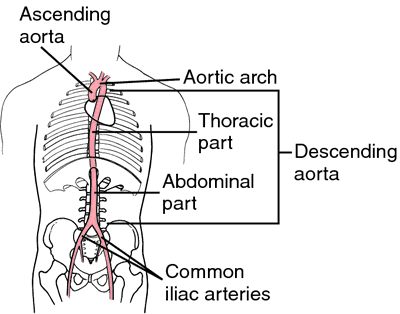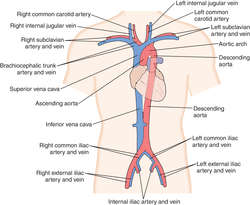aorta
(redirected from aortal)Also found in: Dictionary, Thesaurus, Encyclopedia.
aorta
[a-or´tah] (pl. aor´tae, aortas) (L.)
a·or·ta
, gen. and pl.a·or·tae
(ā-ōr'tă, ā-ōr'tē), [TA]aorta
(ā-ôr′tə)a·or·ta
, pl. aortae (ā-ōr'tă, -tē) [TA]aorta
(ā-ort′ă ) (ā-ort′ē) plural.aortaeaortas [L. aorta fr Gr. aortē, the large artery]The aorta is about 3 cm in diameter at its origin in the upper surface of the left ventricle. It passes upward as the ascending aorta, turns backward and to the left (arch of the aorta) at about the level of the fourth thoracic vertebra, and then passes downward as the thoracic aorta to the diaphragm, and below the diaphragm as the abdominal aorta. The latter terminates at its division into the two common iliac arteries. At the junction of the aorta and the left ventricle is the aortic semilunar valve, which contains three cusps. This valve opens when the ventricle contracts and is closed by the backup of blood when the ventricle relaxes. See: illustration
The divisions of the aorta are as follows:
Ascending aorta (two branches): Two coronary arteries (right and left) provide blood supply to the myocardium.
Aortic arch (three branches): The brachiocephalic artery divides into the right subclavian artery, which provides blood to the right arm and other areas, and right common carotid artery, which supplies the right side of the head and neck. The left common carotid artery supplies the left side of the head and neck. The left subclavian artery provides blood for the left arm and portion of the thoracic area.
Thoracic aorta: Two or more bronchial arteries provide blood for bronchi. Esophageal arteries provide blood to the esophagus. Pericardial arteries supply the pericardium. Nine pairs of intercostal arteries supply blood for intercostal areas. Mediastinal branches supply lymph glands and the posterior mediastinum. Superior phrenic arteries supply the diaphragm.
Abdominal aorta: The celiac artery supplies the stomach, liver, and spleen. The superior mesenteric artery supplies all of the small intestine except the superior portion of the duodenum. The inferior mesenteric artery supplies all of the colon and rectum except the right half of the transverse colon. The middle suprarenal branches supply the adrenal (suprarenal) glands. The renal arteries supply the kidneys, ureters, and adrenals. The testicular arteries supply the testicles and ureter. The ovarian arteries (which correspond to internal spermatic arteries of the male) supply the ovaries, part of the ureters, and the uterine tubes. The inferior phrenic arteries supply the diaphragm and esophagus. The lumbar arteries supply the lumbar and psoas muscles and part of the abdominal wall musculature. The middle sacral artery supplies the sacrum and coccyx. The right and left common iliac arteries supply the lower pelvic and abdominal areas and the lower extremities.
aorta
The main, and largest ARTERY of the body which springs directly from the lower pumping chamber on the left side of the heart and gives off branches to the heart muscle, the head, arms, trunk, chest and abdominal organs and legs.aorta
the ‘great artery’ of the mammalian BLOOD CIRCULATORY SYSTEM. It carries oxygenated blood from the left ventricle of the heart around the AORTIC ARCH and along the dorsal aorta which runs the length of the trunk, giving rise to several branches to individual body organs. The ventral aorta is the main artery in fish and lower chordates which carries blood from the heart to the gills.Aorta
a·or·ta
, pl. aortae (ā-ōr'tă, -tē) [TA]Patient discussion about aorta
Q. Why does Aortic stenosis causes an enlarged heart? My father was recently diagnosed as suffering from enlarged heart due to his Aortic stenosis. what is the connection between those to conditions? As far as I understand that aortic stenosis mean that the aortic valve is too small not too large...
this is called Left Ventricular Hypertrophy or LVH in abbreviations.
this is a classic LVH E.C.G.
http://www.frca.co.uk/images_main/resources/ECG/ECGresource39.jpg
Q. How does alcohol affect someone who has been diagnosed with aortic valve stenosis? My brother has been diagnosed with aortic valve stenosis and also is a smoker and does drink alcohol on the weekends. He knows that he should stop smoking but what about the effects of alcohol? Does this also contribute to his stenosis?
Q. Is there a good screening test for aortic abdominal aneurysm? A friend of mine was diagnosed with an aortic abdominal aneurysm. I am afraid i might have this condition too. is there any screening test that is good for me?

